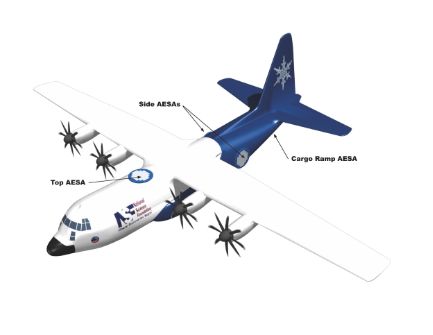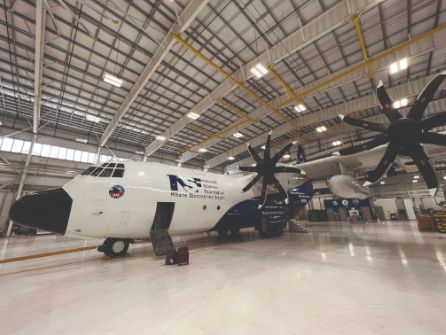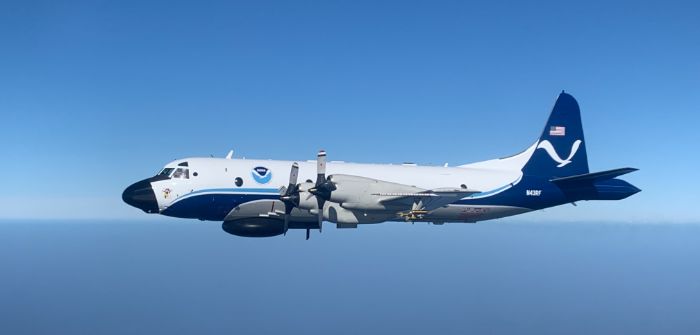In June 2023 the US National Science Foundation (NSF) announced a grant of nearly US$92m to the US National Center for Atmospheric Research (NCAR) to fund a new airborne radar technology. Known as the Airborne Phased Array Radar (APAR), the system will be fitted to the NSF/NCAR C-130 aircraft and used in the study of high-impact weather events such as hurricanes, tornadoes, derechos and blizzards.
Linnea Avallone, the NSF’s chief officer for research facilities, believes APAR represents a major step forward for climate science. “From the science perspective, I think this radar will bring us a generational leap in our ability to observe severe weather, understand the dynamics of storms, and look at the microphysics particulates in clouds and how they evolve,” she says.
According to Jonathan Shannon, public affairs specialist at NOAA, APAR’s C-band dual Doppler system offers the possibility of “superior storm mapping capability, as well as increased range and scan rate, and the potential to provide direct vertical wind speed estimation using the top and bottom panels”.
The leap forward offered by APAR is not simply a matter of a technology upgrade. With climate change making extreme weather events more likely in the future, the need to be able to understand and better predict these events is becoming increasingly important.
As NCAR director Everette Joseph puts it: “As society struggles with an increase in devastating extreme weather events, it’s imperative that the Earth system science community has the tools it needs to provide the actionable information that communities need to become more resilient.”
Half a century in the making
Phased array radar technology has been in use since the 1970s, when it was primarily used by the military for aircraft tracking. While the meteorology sector had long been interested in the technology’s potential for weather forecasting, particularly of extreme weather events such as tornadoes, it was not until 2000 that the US Navy agreed to loan a phased array antenna to the NOAA’s National Severe Storms Laboratory in Oklahoma for research purposes.
Around the same time, two scientists from NCAR – Wen-Chau Lee and Eric Loew – thought of using phased array for airborne climate study. “At the time we were just brainstorming,” says Loew, lead engineer for the APAR project. “We did not really have any idea of how viable the idea would be. It was just kind of drawn on the back of a napkin and then, over time, the technology caught up with our idea.”
One important technological leap in those intervening years was the integration of dual polarimetric capabilities into phased array. Dual polarization, or dual-pol for short, is a radar feature that enables meteorologists to determine what type of precipitation is present in the clouds by measuring the water droplets’ size and shape.
While dual-pol is common to most weather radars, for many years it did not exist for phased array technology. APAR, however, will combine dual-pol capabilities with the agile scanning capability of phased array.
According to Lee, this could significantly advance meteorologists’ ability to observe, as well as ultimately predict, high-impact weather events. “Phased-array technology is very likely to be the future of meteorological radar,” he says.
 The sky’s the limit
The sky’s the limit
Until now, most weather Doppler radar systems have relied on a single transmitter and antenna that swivels on a fixed axis as it scans the skies. For airborne radar, these antenna are usually mounted on the aircraft’s tail.
The tail-mounted radar spins on an axis that is perpendicular to the airplane’s fuselage, which gives it limited range in terms of the amount of the sky it is able to scan. By contrast, phased array technology features flat panel antennas that contain thousands of miniature transmitters and receivers that can be digitally programmed to send beams in almost any direction.
The result, says Avallone, is a “tremendous improvement in the spatial and temporal resolution of what you’re observing”. Another advantage of phased array is the lack of moving parts, which means that “from an operational perspective, you definitely have a lot less maintenance to worry about”.
A further advantage is that phased array operates in the C-band, the 5cm wavelength band that can penetrate a lot deeper into storms. “It has a lot less attenuation from the cloud particulates and water vapor than the X-band, which is the 3cm wavelength that you commonly find on airborne radar,” Avallone says.
Phased array is also a much more efficient way to scan the atmosphere, because changes happen more slowly than the pace at which radar scans. Because of this, much of the atmospheric data collected by traditional fixed-antenna radar is superfluous, as the pulses are returning data for an atmospheric state that hasn’t changed.
The multidirectionality of phased array means that the radar doesn’t have to waste time scanning a portion of the atmosphere that isn’t changing. Instead, the beam can be directed to other areas of the sky, returning to the original area in time to register atmospheric change.
“So we’re not wasting a bunch of samples as you would in a mechanical system where you don’t have a choice,” says Loew. “We can be more judicious about how we collect the data.”
“In addition, the extra spatial resolution offered by phased array will make it possible to observe atmospheric data that until now has been hard to capture with traditional fixed antenna systems,” says Lee.
One such metric is vertical velocity. “Scientists are very interested in this vertical velocity metric because that is the component that will move the air parcel upward for the water vapor to condense,” continues Lee.
With fixed Doppler radar technology this metric can only be derived, but with the APAR system the phased array beam “can be pointed vertically to collect the particle motion”.
APAR Observing Simulator
Despite all the possibilities offered by phased array, the technology is not without its drawbacks. One limitation is variability in the beam width. “The beam width,” says Lee, “is a function of the wavelength and the size of antenna.”
Since the size of parabolic antennas does not alter, the beam width stays the same for traditional radar systems. However, in phased array, when the beam steers away from the axis perpendicular to the antenna, the beam width expands. These variations in beam width can affect the results somewhat.
 NCAR is developing a digital twin of the phased array known as the APAR Observing Simulator (AOS), with which it will be possible to test how factors like beam-width variability play out ahead of APAR’s real-world deployment.
NCAR is developing a digital twin of the phased array known as the APAR Observing Simulator (AOS), with which it will be possible to test how factors like beam-width variability play out ahead of APAR’s real-world deployment.
“The AOS package will allow scientists to fly an aircraft into a simulated storm in a virtual space,” says Lee, who describes AOS as “a sandbox for scientists to play in”.
Scientists will likely have a long time to enjoy playing in that sandbox, as NCAR does not expect to have its phased-array radar up and running on the C-130 until 2028. NCAR is partnering with NOAA and Ball Aerospace and a number of universities to build the APAR antennas.
In the final configuration, four antennas will be fitted to the fuselage: one on the top, one on the bottom, two on each side. Although the antennas are placed flat on the fuselage, “The shape is not as aerodynamic as with the tail-mounted Doppler radar, which is a key factor in the development and part of the tricky nature of it,” Loew says.
Real-world application
The project will be the first time APAR tech has been used in climate science. Airborne weather radar has two main advantages over ground-based radar. The first is that it enables observations in places ground-based radar cannot reach, such as over oceans and polar regions.
The second is that it can provide more granular detail by being able to get much closer to extreme weather events. Once fitted with the APAR technology, NCAR’s C-130 aircraft will be based at the public-use Rocky Mountain Metropolitan Airport in Boulder, Colorado. From there the NSF will support its use “on field observations around the world”, according to Avallone. As with other storm-chaser aircraft, the C-130 will likely be piloted by ex-military personnel who have been given specialized training “for flying in these types of conditions”.
The aircraft will be used exclusively for research purposes. “It could go anywhere in the world but we wouldn’t necessarily just deploy because there’s a big hurricane coming,” Avallone says. “We would want there to be a research purpose that we then supply the aircraft for.”
In terms of the types of research, Avallone says, “Over the past couple of decades, we have worked to support the study of every kind of meteorological phenomenon that you can think of.” This includes the study of hurricanes, tropical cyclones and winter storms, as well as atmospheric rivers. While the phased array tech deployed by NCAR will be restricted to research, NOAA will be watching closely the development and implementation of APAR with a view to further expanding the technology for airborne weather forecasting.
Recognizing the potential benefits of APAR, NOAA provided a series of grants totaling US$8.5m between 2017 and 2022 for the initial research and development, and going forward will be supporting further development with an additional US$11.2m in funding, according to Shannon.
“NOAA is interested in the further development of APAR as a potential system to replace the data collected by the tail Doppler radar (TDR) flown on its two WP-3D Orions, which will retire from service in 2030 and then be replaced by C-130J aircraft,” says Shannon.
This article originally appeared in the September 2023 issue of Meteorological Technology International. To view the magazine in full, click here.



